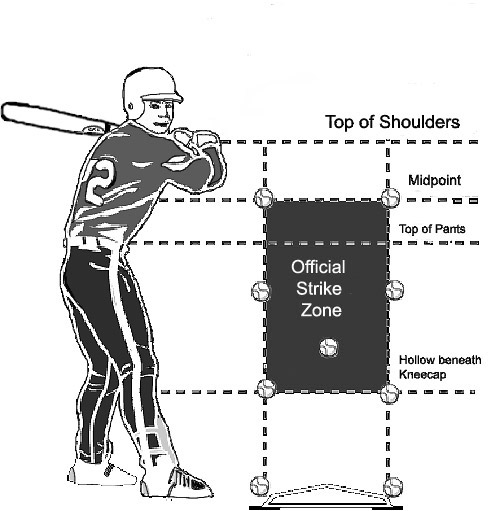|
Definition of Strike Zone |
|
| The Strike Zone is that area over home plate, the
upper limit of which, is a horizontal line at the midpoint
between the top of the shoulders and the top of the uniform pants,
and the lower level is a line at the hollow beneath the knee
cap. The Strike Zone shall be determined from the batter's
stance as the batter is prepared to swing at a pitched ball.
High School rules state that the upper limit of the Strike Zone is halfway between the shoulders and the waistline. This seems to be just different words meaning the same thing. People will argue that there are several inches of difference: 1) the top of the uniform pants is probably as much as 2 inches above the waist; 2) Saying just the shoulders and not the top of the shoulders is open to interpretation. This makes the upper limit in High School and AAU half a baseball lower than Pro rules (Dizzy Dean). Additionally, both sets of rules specifically mention a batters stance and not his walking posture. Certainly the zone does not change if the batter lowers himself during the pitch. The initial slightly bent stance is the determining factor. In either case, the upper limit of the Strike Zone would appear to be about letter high or just under the elbows of the batter. |
 |
|
Rules about Strikes |
|
| A Strike is a legal pitch so called by
the umpire, which a) is struck at by the batter and missed b) is not struck at but any part of the ball passes through any part of the strike zone c) is fouled by the batter when he has less than two strikes d) is bunted foul e) touches the batter as he strikes at it f) touches the batter in flight in the strike zone g) becomes a foul tip |
Only the edge of the ball needs to
touch just an edge of the strike zone. If you expect the whole
baseball to cross the strike zone you are about 3 inches off on each
side of the plate. This is a learned skill, much like driving
a car and keeping it between the lines when you cannot see the edge
of the road. New umpires tend to focus on the center of the
baseball. Find an imaginary line a baseball width wider than the
plate. Pretend the plate is 6 inches wider than it is. Now where is
the ball?
If a pitched ball is in the strike zone, it is a strike even if it hits the batter. If the batter crowds the plate and gets hit by a pitch, but the pitch is in the strike zone, or if the batter swings at a pitch, even if it would have been called a ball, and the pitch hits him - it is still a strike and batter does not get first base. |
| A foul tip is not the same as a foul ball. If the batter swings and and makes contact with a pitched ball and the ball goes directly to the catcher's mitt and the catcher holds on to the catch, it is a foul tip and treated just like a strike. The ball is live. If it is the third strike, the batter is out, because it is JUST a strike. | |